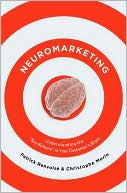Book Review: Neuromarketing
 I breezed through a bunch of marketing books this weekend, but the one that really stood out as useful was Neuromarketing by Patrick Renvoise and Christophe Morin. If you do marketing in any way, shape or form this book should be on your “to read” list. It describes how the brain makes decisions and how you can hone your designs and messages to give your organization a competitive advantage.
I breezed through a bunch of marketing books this weekend, but the one that really stood out as useful was Neuromarketing by Patrick Renvoise and Christophe Morin. If you do marketing in any way, shape or form this book should be on your “to read” list. It describes how the brain makes decisions and how you can hone your designs and messages to give your organization a competitive advantage.
Neuromarketing discusses the three parts of the brain and their function:
- New Brain: Processes rational data. This part of the brain may not be fully formed until you are 24-years-old.
- Middle Brain: Processes emotions and gut feelings.
- Old Brain: The real decision maker. This is the first part of the brain to develop and makes all decisions. It’s sole concern is the physical survival of the body. The old brain is 45,000 times older than the written word, which means that written words don’t impact it.
When the old brain makes decisions, it consults with the new and middle brain. This leads to emotionally-led decisions, which are then justified rationally.
So how do you reach the old brain, since it doesn’t understand words? The authors offer several suggestions to appeal to the old brain in terms that it recognizes:
- An Audience-Focused message: The old brain is not concerned with anything not related to its own well-being. Therefore your messages must be 100% audience focused. They don’t care about your organization. They care how your organization can help THEM.
- Contrast: Use contrasting examples, such as before/after, risky/safe, with/without, fast/slow, etc.
- Tangible Input: Ideas should be simple and easy to grasp. Make sure your audience can easily recognize and process your terms (such as dollar value).
- Focus on the Beginning and the End: Put the most important points at the beginning of a message (this can also apply in a presentation). The once the old brain has assessed that there is no immediate danger, it will try to conserve energy by paying less attention to the middle of the message.
- Visual Stimuli: The old brain responds to visuals before the new brain has time to process what they mean.
- Emotion: We remember events better when we’ve experienced them with strong emotion. If customers can’t remember your message, why would they choose your product?
Now that we know what the old brain will pay attention to, the authors offer a four-point plain for integrating these strategies into our marketing plan:
Diagnose the Pain: You have to figure out what “pain” your audience is experiencing - what do they really want/need? What benefits do you have that relieve that pain? For example, when Dominoes found out that the real reason customers weren’t utilizing delivery was that they were worried about the time it would take for the pizza to get to their house, they implemented a 30-minute guarantee. The pain of your audience falls into three categories: financial, strategic or personal. Marketing efforts should focus on the things that cause the MOST pain, rather than things that your audience doesn’t really care about. Finally, your audience must acknowledge that they have a certain pain in order for your offer of relief to appeal to them.
Differentiate Your Claims: The old brain responds to clear, solid contrast. How are you different than your competitors? How are you different than doing nothing? What’s UNIQUE about what you’re selling? Don’t just say that you’re one of many companies that offer basically the same thing. You may have to be creative about your claim of differentiation but if you aren’t different, you’re basically selling your competitors products for them.
Demonstrate the Gain: Now that you’ve differentiated yourself from your competitors, you have to demonstrate through a tangible message that your audience will benefit from your product. You can do this through stories, an actual demo, data that relates back to tangible value or a vision statement (though this tactic is the least affective because it requires faith.
Deliver to the Old Brain: It’s critical to deliver this message in the way that the old brain will understand, which you can do by grabbing the user’s attention right off the bat, using big picture analogies, making sure your claims are clearly articulated and using phrases that appeal to our self-centered nature by using key words like “you”.
Overall, this book is definitely worth the $22 I paid for it. It’s full of practical and applicable information that can be incorporated into any marketing campaign.



No comments:
Post a Comment